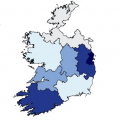
Employment And Skills
7 Jun 2017Key Point
Less than half of Irish low-skilled workers were employed in 2016. Upskilling and re-training opportunities for such individuals are essential.
Introduction
Ireland’s unemployment rate has decreased significantly in recent years1 . The unemployment rate as of May 2017 was 6.4pc. The monthly unemployment rate as found in May of each year over the period 2007 to 2017 is shown below.
Figure 1 – Unemployment Rate May of Each Year, 2007 – 2017

(Source: CSO (2017), Monthly Unemployment Series)
Figure 1 shows that the unemployment rate more than doubled between 2008 and 2009, from 126,100 to 270,200. The seasonally adjusted number of unemployed persons in May 2017 was 140,700. There are more males’ unemployed (85,900) than females (54,800). The total unemployment number has more than halved (-55.2pc) from a peak in 2012 of 314,000 persons to 140,700 in 2017.
Unemployment Rate of those with Low Skills
Eurostat notes low skilled persons are those with lower secondary education. The employment rates of such persons aged 20-64 across the Member States of the EU28 in 2016 are shown in table 1.
Table 1 – Employment rate (%) of low skilled persons, aged 20 – 64
In 2016, Ireland’s employment rate among low skilled persons was 49pc, which was below the EU average (53.6pc). The highest employment rate was found in Portugal (64.7pc), followed by the UK (62.1pc) and Denmark (61.8pc). The gap between the employment rate of low skilled workers in Ireland and the UK is significant at 13.1pc. Figure 2 shows unemployment rates of those across different educational attainment levels in Ireland between 2007 and 2016.
Figure 2 – Unemployment Rate by Educational Attainment Level in Ireland
Figure 2 shows that the unemployment rate among those who attained lower secondary education or below had an unemployment rate of 14.5% in 2016, which is two-thirds higher than the rate for those with upper secondary and post-secondary (non-tertiary) education (8.7%), and almost three times the rate for those with tertiary education (4.9%).
Skills Gap
The European Commission3 has recently stated that –
The disparities between the employment rates of low-, medium- and highly-skilled workers [in Ireland] are among the highest in the EU. Skills mismatches and skills shortages have emerged in certain areas, while upskilling and reskilling opportunities are insufficient.
The Commission recommends addressing this skills gap through improved targeted initiatives.
__________________________________
Notes:
1 Unemployed: persons who, in the week before the survey, were without work and available for work within the next two weeks, and had taken specific steps, in the preceding four weeks, to find work.
2 The employment rate is the number of employed aged 15 to 64 expressed as a percentage of the total population aged 15 to 64.








